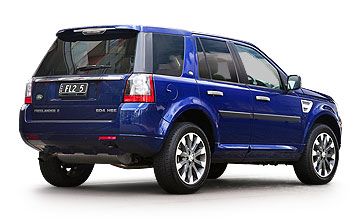BY HAITHAM RAZAGUI | 26th Sep 2012

It makes sense, because Land Rover started off a high base with the second-generation vehicle and has since applied facelifts and annual running changes, ironing out foibles, adding engines, improving equipment and refining the looks.
The again, sitting at traffic lights with the 2.2-litre turbo-diesel engine at idle results in the words ‘rattly’ and ‘vibration’ coming to mind, although it settles down to almost silence once cruising along.
That, the pricy options (including dated sat-nav) and a flimsy indicator stalk were all we could really find to fault with the Freelander – not a bad rap sheet.
Our test car, the second-from-top SD4 SE with a list price of $56,810 plus on-road costs, was optioned up to $64,755 with the addition of premium metallic paint ($2300), Satellite navigation ($2500), a cold climate pack ($1200), front parking sensors ($900), Piano black lacquered veneer ($750) and a rear spoiler ($295).
Australia seems an odd location to offer a cold climate pack, but our test took place in the middle of a Victorian winter and we relished the addition of heated front seats, making up for the irrelevance of a heated windscreen and warmed washer jets.
The cost of our car’s Havana premium paint finish seems a bit of a rort but combined with the roof spoiler, it did lend the car a touch of class and the look of a miniature Range Rover Sport.
Although easy to use, the touch-screen satellite navigation is a slow and dated device that sits above, but is not integrated with, the nine-speaker Alpine audio system and its cost is a joke given Hyundai fits a superior setup to a $25,000 i30 as standard.
On first impressions, the Freelander’s interior felt a bit dated and utilitarian but it soon grew on us, and we were fond of the ‘almond’ colour scheme.
At the time of writing, Land Rover had just published the first images of an upcoming Freelander update and we are pleased to see most of the chunky elements we were fond of will remain while the overall look is modernised.
Captain’s chair style front seats come with individual adjustable fold-down armrests but taller drivers could do with a bit more thigh support and we frequently reached for the lumbar adjuster to relieve ourselves from a feeling of being pushed forwards while trying to settle in.
Other than that the driving position is comfortable, while all-round visibility and a commanding view of the road enable the Freelander to shrink around the driver and feel like a smaller vehicle when driving around town.
We liked the big robust-feeling switchgear, especially the chunky, bathroom tap-style knobs and the quality feel and weighting of the metal and rubber Terrain Response selector.
It was easy to manually dial a phone number for the Bluetooth hands-free system, which was simple to pair devices with – although the tiny matrix screen was decidedly old-school.
We give a thumbs up to the big glove box and well-designed cup holders but more cabin storage areas would be nice, as would some hooks and lashing points in the boot.
In the back, legroom is at a premium if you have a tall passenger behind a tall driver but it is not too bad for this size category and roughly on a par with mid-size sedans and compact SUV rivals.
On the move, we found the one-touch cruise control refreshingly simple to use, especially compared with the wiper stalk that took us some time to get used to.
The ventilation recirculation turns itself off automatically, which was annoying given that for some reason the Freelander seems worse affected than most cars by smelly fumes from other vehicles.
Overall the Freelander felt well screwed together, although we reckon weightier stalks would prevent the high-beam being accidentally activated when indicating with the headlights on.
The 140kW/420Nm turbo-diesel engine has plenty of power and grunt and never felt as though it was struggling, but it gets noisy under load, while the six-speed automatic transmission is smooth and does the job.
We achieved fuel consumption in the low eights in mixed driving, an acceptable figure and not too far from the official 7.0 litres per 100 kilometres on the combined cycle.
The steering could do with a bit more feel to it and has a slow initial response, while body-roll in corners reduces confidence.
However once accustomed we found the Freelander hangs on when set into a turn and feels admirably nimble, changing direction deftly on chicanes and roundabouts.
It is a great compromise as the Freelander rides comfortably, ironing out potholes and drain covers round town while positively wafting along country roads and motorways.
A weekend jaunt from Melbourne to Philip Island allowed us to stretch the Freelander’s legs and it impressed us with its relaxed kilometre-munching abilities, with acceptable levels of road and wind noise.
The trip provided precious few opportunities to test the baby Landie’s off-road abilities but a quick spin around a heavily rutted, waterlogged muddy paddock – with the Terrain Response selector set appropriately to ‘mud and ruts’ – revealed an admirable talent for driving in the slop.
Later speaking with a local, we were informed he had once seen an abandoned HiLux “up to its windscreen in mud” in said paddock, making us feel lucky to have survived intact.
Unlike other posh SUVs, the Freelander has plenty of character and felt like an honest-to-goodness, does-the-job kind of vehicle that has the edge of knowing you can get it dirty and rugged, unlike other posh mid-sized SUVs.
This adds to its classless appeal, which is why we would rather have a Freelander than the comparably poncy – and slightly pricier – Audi Q5 or BMW X3.
In addition, while we admire the Evoque’s dramatic styling and impressive dynamics, it looks like a try-hard beside the mature and restrained yet classy and capable Freelander.